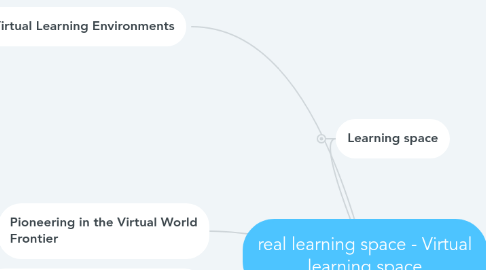real learning space - Virtual learning space
by michele notari

1. Learning space
1.1. Learning space - Wikipedia
2. An investigation of motivation and experience in virtual learning environments: a self-determination theory
2.1. An investigation of motivation and experience in virtual learning environments: a self-determination theory
2.2. With the development and evaluation of information technology, virtual reality technology provides opportunities to offer an immersive and interactive experience for supplementing traditional classroom lecture and creating innovative online learning in education curricula and professional training. Given that the arena of 3D entertainmentoriented virtual worlds is creative and quickly evolving, applying a theory-based motivational model to examine the properties of virtual world environments in the context of education remains relatively unexplored territory. Thus, the present study applies the research frameworks of Self-Determination Theory (SDT) and hedonic theory to an understanding of how 3D virtual reality technology contexts satisfy or obstruct psychological needs and thus foster or undermine sustained engagement, affecting behavioral intentions. This study extends existing literature in the field by showing that psychological needs and hedonic experience are important components in understanding virtual reality technology and human interaction. The findings are important in explaining the value of 3D virtual reality technology in educational applications that contribute to the overall enhancement of the learner’s motivation and learning experience.
3. Pioneering in the Virtual World Frontier
3.1. Immersion in virtual worlds presented opportunities for simulating the qualities valued in face-to-face classes with the flexibility afforded by online learning. Immersive learning engaged educators, curriculum designers, campuses, conferences, and educational community groups to devise new ways to collaborate and engage learners. Dreaming of opportunities that were not possible in the online classroom, educators saw the potential of building communities in virtual worlds. They gathered to share their and to employ novel approaches to address educational challenges. This chapter explores the phenomenon of selfhood and society integral to the development of a vibrant educational community. At the heart of virtual world education is an ecosystem of institutions, groups, and conferences comprised of the early adopters and pioneers who stimulated their imagination and pooled their resources to encourage and strengthen the community and cast their eye to the future.
3.2. Pioneering in the Virtual World Frontier: Education Book Chapter | IGI Global
4. Virtual learning environment engagement and learning outcomes at a‘bricks-and-mortar’university
4.1. https://www.sciencedirect.com/science/article/pii/S036013151830174X
4.2. In this study, we analyse the relationship between engagement in a virtual learning environment (VLE) and module grades at a ‘bricks-and-mortar’ university in the United Kingdom. We measure VLE activity for students enrolled in 38 different credit-bearing modules, each of which are compulsory components of six degree programmes. Overall we find that high VLE activity is associated with high grades, but low activity does not necessarily imply low grades. Analysis of individual modules shows a wide range of relationships between the two quantities. Grouping module-level relationships by programme suggests that science-based subjects have a higher dependency on VLE activity. Considering learning design (LD), we find that VLE usage is more important in modules that adopt an instruction-based learning style. We also test the predictive power of VLE usage in determining grades, again finding variation between degree programmes and potential for predicting a student's final grade weeks in advance of assessment. Our findings suggest that student engagement with learning at a bricks-and-mortar university is in general hard to determine by VLE usage alone, due to the predominance of other “offline” learning activities, but that VLE usage can nonetheless help to predict performance for some disciplines.
5. Enhanced Virtual Learning Spaces Using Applied Gaming
5.1. Online virtual labs, emulate real laboratories where students can accomplish a number of learning tasks and receive courses that otherwise would be difficult if not infeasible to be offered. In reaching this challenging goal, we developed two virtual labs enhancing students knowledge by providing an entertaining and engaging experience. Ensuring that the educational requirements of educators and students will not be overlooked, extensive evaluations of the virtual labs were deployed. Both virtual labs were accompanied with game analytics enabling detailed tracking of learner behavioral data. Tracking and understanding behavioral data facilitated decision-making at the design level of a lab, but also allowed for adapting learning content to the personal needs of the students.
5.2. Enhanced Virtual Learning Spaces Using Applied Gaming
6. Virtual Learning Environments
6.1. software? No, the concept includes several interesting features that justify the use of a specific label. We review these features in the first part of our contribution. Do these features guarantee pedagogical effects? No, we review in the second some potential contributions of virtual learning environments.Turning potential effects intro actual outcomes is the challenge of designers
6.2. Virtual Learning Environments
7. List of all links
7.1. https://www.diigo.com/user/michele3?query=thinktank
8. Is There Any Real Virtue of Virtual Reality? - Medical study..
8.1. Surprisingly, these advantages may be more imagined than real. Implicitly, these models assume that the learner can accurately assimilate and remember spatial information from multiple viewpoints. However, some evidence suggests that humans actually synthesize spatial information presented in oblique orientations by first rotating back to a standard (top, side, front) view, then learning the visual information.1 If so, presenting information in multiple orientations may place a heavy load on the individual’s ability to rotate the figure. This load will be seen most acutely in those with relatively poorer spatial ability, since mental rotation is a critical element of spatial ability.2 Consequently, studying projections of a 3D object in an orientation in which an object is best visualized and least obscured (called canonical or key viewpoints) may be all that is necessary. Once learned, the object in memory can be mentally rotated to enable recognition of new objects.
8.2. Is There Any Real Virtue of Virtual Reality?: The Minor... : Academic Medicine


